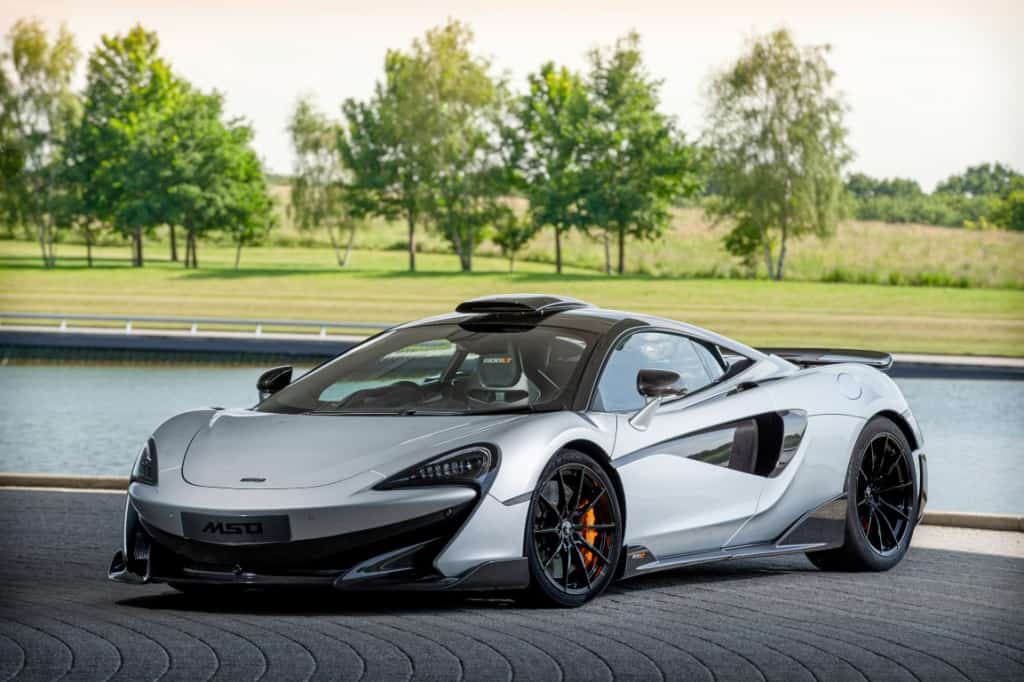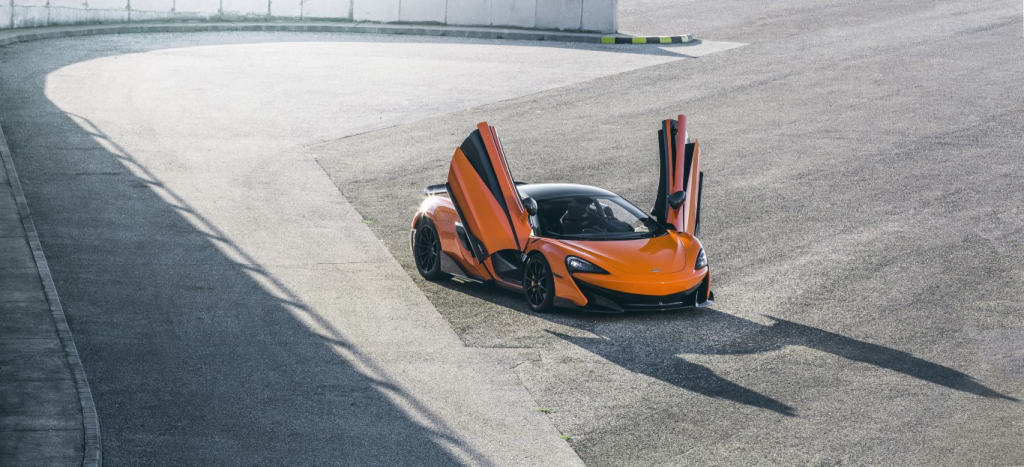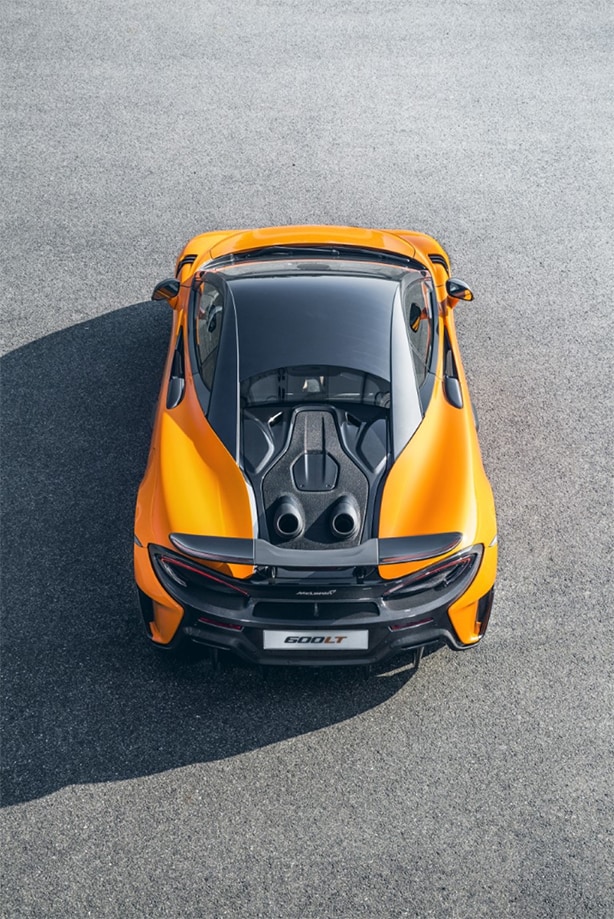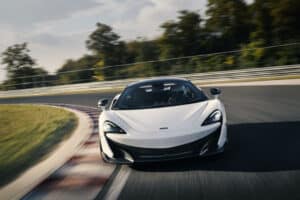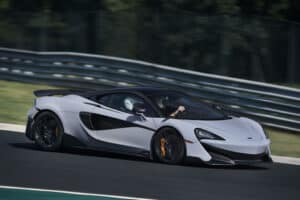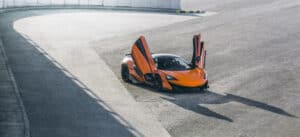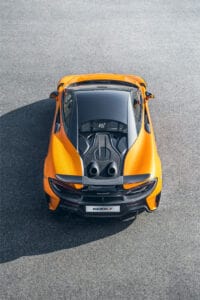And it’s longer, right?
Technically yes, it’s 74mm longer thanks to new spoilers front and rear that help squash the 600LT into the tarmac at speed, increasing aerodynamic grip. But length in itself isn’t really the point, says McLaren, it’s more the spiritual link back to its F1 GTR Longtail, the most extreme evolution of McLaren’s Le Mans racecar. It debuted in 1997 and featured longer, more slippery bodywork to increase maximum speed on long straights.
What are the key changes?
The 600LT is an evolution of the already feathery 570S, but weight falls by a further 100kg or so to a minimum of 1356kg when all lightweight options are specified. Key contributions come from carbonfibre seats (-21kg), forged alloy wheels (-17kg), shorter top-exit exhausts (-12.6kg) and some carbonfibre bodywork (-7.2kg). Air-con is a no-cost option, which allows McLaren to claim a further 12.6kg saving, though few cars will leave the factory without it.
The 3.8-litre twin-turbo V8 is 30bhp more powerful at 592bhp, and the dual-clutch gearbox’s shift times are apparently 25 per cent swifter than the already punchy 570S. McLaren claims 2.9sec from zero to 62mph, 8.2sec to 124mph and a 204mph top speed, compared with 3.2sec, 9.5sec and 204mph for a 570S.
The chassis gets a thorough going over with double-wishbone suspension and carbon-ceramic brakes lifted straight from the pricier 720S Super Series model (saving another 14.2kg). There are stiffer springs, re-tuned adaptive dampers, a wider track and all 600LT’s are fitted with extremely sticky Pirelli Trofeo R tyres. Add in stiffer engine mounts, 3 per cent faster steering and more responsive throttle and brake pedals and there’s a lot more going on beneath the skin than you might think.
What’s the McLaren 600LT like to drive?
We’re driving the 600LT on the Hungaroring F1 circuit, and it doesn’t take long to feel this junior Longtail model is infused with the same likeably raw feel and energy as the 675LT. There’s extra definition to deliciously tactile steering, even less body roll than the already taut 570S, and a firmer, more precise feel generally.
This is a delicate, highly responsive car to drive hard on track, partly because of the inherent balance of its mid-engined layout but also in large part because of the lightweight carbonfibre chassis and the extensive chassis modifications versus a 570S.
Lean hard on the exceptional carbon-ceramic brakes and there’s a real positivity to the way the 600LT locks on to the apex of a corner. Lift the throttle and it’ll eagerly tighten its cornering line, and when you plant the throttle it’ll power out in the most satisfying little drift. It’s a car that invites you to drive hard and play with its balance, but never feels scary or unruly.
As with all McLarens, you still need around 3500rpm for the turbochargers to really kick, but there’s a meaner soundtrack from those top-exit exhausts and more intense acceleration when the turbos are lit to make the rush to the redline never less than eye-widening. Equally, though, the more affordable Porsche GT3 RS has the crisper and more exciting powertrain.
In a nutshell
The 675LT and 570S are two of the greatest high-performance models of the last few years, so it’s a win-win that the 600LT successfully bridges the gap between the two – especially as it’s the raw, highly textured character of the Longtail that shines through most clearly. This is a car that’s not only quick and capable, but also puts the driver at the core of the experience with its tactile feel, nuanced communication and a handling balance that’s both playful and secure. It is a fabulously interactive thing to drive.
Only a limited number of both Coupe and Spider models will be produced, and all are likely to be fully accounted for by the close of 2019. Given its restricted supply and the way the 600LT drives, expect used examples to stay in strong demand. You can view used McLaren 600lt cars for sale on finance as well as the whole range of used McLaren cars.
Similar car reviews
An alternative review to the 500lt is the McLaren GT, McLaren’s first grand tourer, with a focus on luxury and comfort, this is a great car to drive.
We’ve also reviewed two Aston Martin’s. The Aston Martin DBS Superleggera Volante is the convertible version of their range-topping DBS, and with a lightweight carbon fibre body it can do a nifty 0-62mph in a benchmark of 3.6 seconds. Closely related to the DBS is the Aston Martin DB11 AMR, and has a new entry price of just £174,995.
We’ve also been lucky enough to drive and review the Ferrari F8 Tributo, the mid-engined V8 supercar which has the discontinued GTB chassis with the Pista’s engine along with updated interiors, as well as a review of the Ferrari 488 Pista, which is a more powerful, lighter, sharper version of the 448 GTB.
Specs
| Price | £185,500 |
|---|---|
| Drivetrain | 3799cc 32v V8 twin turbo, seven-speed dual-clutch, rear-wheel drive |
| Performance | 592bhp @ 7500rpm, 457lb ft @ 5500-6500rpm |
| 0-62mph | 2.9secs |
| Top speed | 204mph |
| Efficiency | 23.2mpg, 276g/km CO2 |
| Weight | 1356kg |
| Length/width/height | 4604/2095/1194mm |





